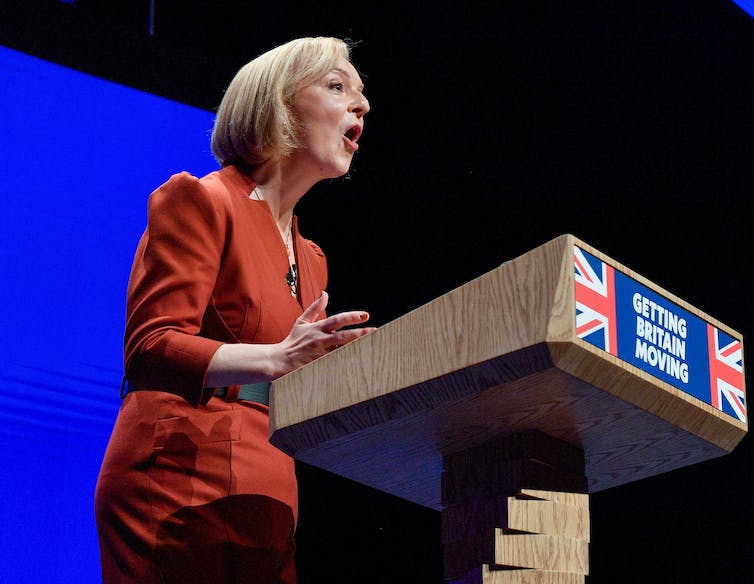During a January 2023 speech on “building a better future” the prime minister, Rishi Sunak, insisted that “we can change our country’s character. We can reverse the creeping acceptance of a narrative of decline.”
Months later, this narrative has manifested in Tory malaise and division, low approval ratings, and collapsing buildings. Sunak recently watered down his climate change mitigation policies, and refused to “speculate” on the future of rail project HS2. The Sunak government is seemingly unable to reverse a harmful narrative or maintain its own.
Writing in The Times, columnist and former Conservative MP Matthew Parris observed that “the best and often only way to rebut a narrative is with a bigger narrative”. But political leaders are successful when they present a grand narrative and find a way to connect themselves to it. Simply finding a bigger narrative is not enough – political leaders must be compelling characters within their narrative.
Illustrating the risks of failure, the loss of a Conservative majority in 2017 was attributed to Theresa May “performing neither the narrative nor the persona”.
In a celebrated keynote speech at the Democratic National Convention in Boston in 2004, Barack Obama remarked that: “I stand here knowing that my story is part of the larger American story … that in no other country on Earth is my story even possible.” Commenting on that speech, author Michael A. Cohen notes that “what makes a great political speech is if you can somehow fold your story into this larger American story”.
Sunak’s big chance to follow suit will be at his first party conference speech as leader and prime minister. In the words of Margaret Thatcher – a figure of admiration for Sunak – this is an opportunity to “inspire the party faithful as well as ease the worries of the doubters”.
But the challenge is daunting and the stakes high. Sunak must counter the existing narrative of a “crumbling Britain”. He must also repair inconsistencies between his self-proclaimed narrative of a “man of the people” and his own present circumstances. While he attempts to convince struggling voters that he understands their difficulties, he is reasonably portrayed as wealthy and out of touch.
Contradictions in Sunak’s narrative
Effective narratives run on empathy. The audience (in this case, the voting public) must feel able to personally connect with the narrative and the narrator.
In a campaign video for his unsuccessful first leadership election bid, Sunak begins with the words: “Let me tell you a story”. It was a story about himself, his family and how Britain “gave them and millions like them, the chance of a better future”.
It is difficult to align yourself with a revival narrative, or an everyman narrative, from a position of privilege. Sunak upgrading the local electricity network to heat his private pool at the height of the energy and cost-of-living crises certainly didn’t help project empathy. Nor did asking a homeless man if he worked in a business.
It’s possible that Sunak’s wealth and privilege may render him singularly incapable of connecting to a bigger narrative at this moment in British history.
Sunak has failed thus far to rebut a narrative of decline. He has been unable to create a convincing new narrative for the country (the “renewal”) or for himself (the “everyman”), much less connect the two.
A narrative of decline
Sunak’s team has already attempted to construct a narrative of his premiership – one of a sensible, cautious man cleaning up the mess left by his predecessor, Liz Truss. As argued in an article in The Economist: “There is just one problem with this narrative. Mr Sunak is a cause of the problem as well as the solution…helping tidy up a mess that he helped create.”
Instead of establishing a new story, Sunak has instead made himself a key character in the narrative of decline he sought to escape. It might have been possible to construct a narrative of Tory revival early in Sunak’s premiership, but if it was in evidence, it was short lived. Local election losses in May were followed by a crisis over collapsing school buildings over the summer.
The IMF recently published a report highlighting Britain’s “challenging economic outlook” and “weak potential growth”. Public services are not forecast to return to pre-pandemic levels of performance before the next election. Resignations and scandals have also continued in Sunak’s government.
Alamy/Dave Johnston
At the Conservative Party conference, Sunak will have another opportunity to seize the political initiative. He may follow the example of Thatcher: when faced with a decline narrative, she chose not to reverse it but to embrace it – and blame it on her opponents.
Harnessing themes of decline can bring significant benefits. Political scientist Robert Ralston argued that narratives of decline “resonate because they acknowledge the pain inflicted by events, point blame, and outline paths forward for healing and renewal”. Thatcher acknowledged widespread crises and mistakes and presented herself as the person to fix them. Narratives of decline are thus part of every politician’s playbook.
In explaining why Truss was unsuccessful with the same strategy, Ralston pointed out that Thatcher was, unlike Truss, a convincing political outsider who “successfully blamed the incumbent Labour Party for Britain’s problems”.
By contrast, 13 years of Conservative incumbency means that Sunak – like Truss before him – is very easily implicated in any decline he might exploit. Moreover, acknowledging (much less sharing) the public’s pain has never come easily to Sunak.
Nevertheless, Sunak has attempted to play the outsider, having been vindicated for his warnings against “Trussonomics”. More recently, in his speech on net zero, Sunak pledged “to change the way our politics works”.
Whatever Sunak decides, reversing the narrative of an impending British collapse or leveraging decline to his advantage, his search for a grand narrative is already replete with incongruities. In the end, the stark realities outside Westminster may force him to acknowledge decline and his role within it.

